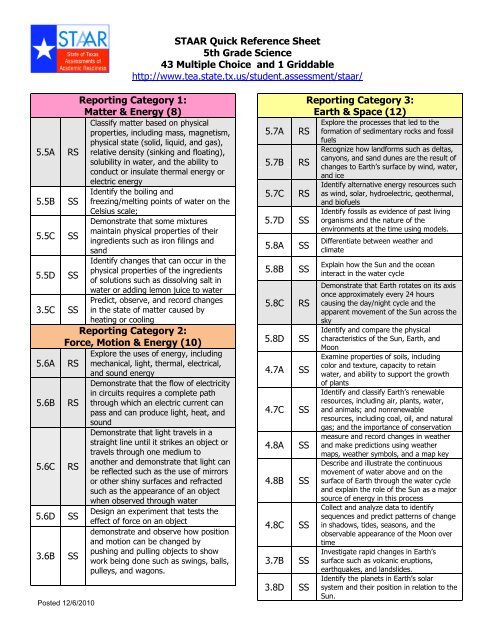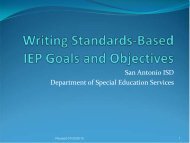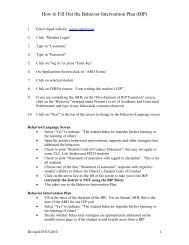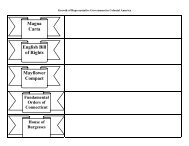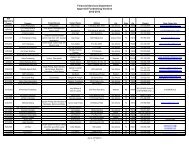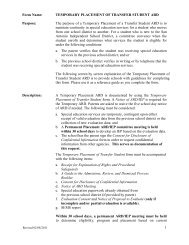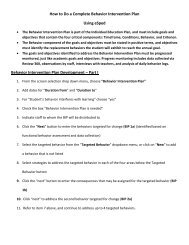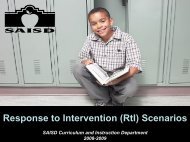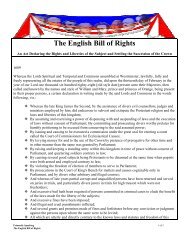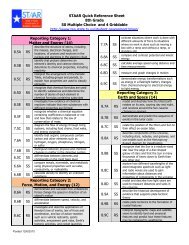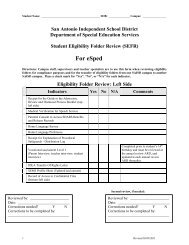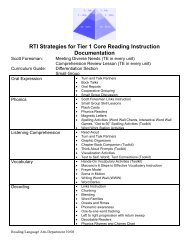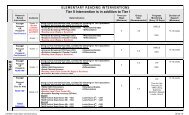5th grade STAAR Science
5th grade STAAR Science
5th grade STAAR Science
Create successful ePaper yourself
Turn your PDF publications into a flip-book with our unique Google optimized e-Paper software.
<strong>STAAR</strong> Quick Reference Sheet<br />
<strong>5th</strong> Grade <strong>Science</strong><br />
43 Multiple Choice and 1 Griddable<br />
http://www.tea.state.tx.us/student.assessment/staar/<br />
Reporting Category 1:<br />
Matter & Energy (8)<br />
Classify matter based on physical<br />
properties, including mass, magnetism,<br />
physical state (solid, liquid, and gas),<br />
5.5A RS relative density (sinking and floating),<br />
solubility in water, and the ability to<br />
conduct or insulate thermal energy or<br />
electric energy<br />
5.5B SS<br />
Identify the boiling and<br />
freezing/melting points of water on the<br />
Celsius scale;<br />
5.5C SS<br />
Demonstrate that some mixtures<br />
maintain physical properties of their<br />
ingredients such as iron filings and<br />
sand<br />
Identify changes that can occur in the<br />
physical properties of the ingredients<br />
5.5D SS<br />
of solutions such as dissolving salt in<br />
water or adding lemon juice to water<br />
Predict, observe, and record changes<br />
3.5C SS in the state of matter caused by<br />
heating or cooling<br />
Reporting Category 2:<br />
Force, Motion & Energy (10)<br />
Explore the uses of energy, including<br />
5.6A RS mechanical, light, thermal, electrical,<br />
and sound energy<br />
5.6B RS<br />
Demonstrate that the flow of electricity<br />
in circuits requires a complete path<br />
through which an electric current can<br />
pass and can produce light, heat, and<br />
sound<br />
Demonstrate that light travels in a<br />
straight line until it strikes an object or<br />
travels through one medium to<br />
another and demonstrate that light can<br />
5.6C RS<br />
be reflected such as the use of mirrors<br />
or other shiny surfaces and refracted<br />
such as the appearance of an object<br />
when observed through water<br />
5.6D SS<br />
Design an experiment that tests the<br />
effect of force on an object<br />
3.6B SS<br />
demonstrate and observe how position<br />
and motion can be changed by<br />
pushing and pulling objects to show<br />
work being done such as swings, balls,<br />
pulleys, and wagons.<br />
5.7A RS<br />
5.7B RS<br />
5.7C RS<br />
5.7D SS<br />
5.8A SS<br />
5.8B SS<br />
5.8C RS<br />
5.8D SS<br />
4.7A SS<br />
4.7C SS<br />
4.8A SS<br />
4.8B SS<br />
4.8C SS<br />
3.7B SS<br />
3.8D SS<br />
Reporting Category 3:<br />
Earth & Space (12)<br />
Explore the processes that led to the<br />
formation of sedimentary rocks and fossil<br />
fuels<br />
Recognize how landforms such as deltas,<br />
canyons, and sand dunes are the result of<br />
changes to Earth’s surface by wind, water,<br />
and ice<br />
Identify alternative energy resources such<br />
as wind, solar, hydroelectric, geothermal,<br />
and biofuels<br />
Identify fossils as evidence of past living<br />
organisms and the nature of the<br />
environments at the time using models.<br />
Differentiate between weather and<br />
climate<br />
Explain how the Sun and the ocean<br />
interact in the water cycle<br />
Demonstrate that Earth rotates on its axis<br />
once approximately every 24 hours<br />
causing the day/night cycle and the<br />
apparent movement of the Sun across the<br />
sky<br />
Identify and compare the physical<br />
characteristics of the Sun, Earth, and<br />
Moon<br />
Examine properties of soils, including<br />
color and texture, capacity to retain<br />
water, and ability to support the growth<br />
of plants<br />
Identify and classify Earth’s renewable<br />
resources, including air, plants, water,<br />
and animals; and nonrenewable<br />
resources, including coal, oil, and natural<br />
gas; and the importance of conservation<br />
measure and record changes in weather<br />
and make predictions using weather<br />
maps, weather symbols, and a map key<br />
Describe and illustrate the continuous<br />
movement of water above and on the<br />
surface of Earth through the water cycle<br />
and explain the role of the Sun as a major<br />
source of energy in this process<br />
Collect and analyze data to identify<br />
sequences and predict patterns of change<br />
in shadows, tides, seasons, and the<br />
observable appearance of the Moon over<br />
time<br />
Investigate rapid changes in Earth’s<br />
surface such as volcanic eruptions,<br />
earthquakes, and landslides.<br />
Identify the planets in Earth’s solar<br />
system and their position in relation to the<br />
Sun.
Reporting Category 4:<br />
Organisms & Environments (14)<br />
5.9A RS<br />
5.9B RS<br />
5.9C SS<br />
5.9D SS<br />
5.10A RS<br />
Observe the way organisms live and<br />
survive in their ecosystem by interacting<br />
with the living and non-living elements<br />
Describe how the flow of energy derived<br />
from the Sun, used by producers to create<br />
their own food, is transferred through a<br />
food chain and food web to consumers<br />
and decomposers<br />
Predict the effects of changes in<br />
ecosystems caused by living organisms,<br />
including humans, such as the<br />
overpopulation of grazers or the building<br />
of highways<br />
Identify the significance of the carbon<br />
dioxide-oxygen cycle to the survival of<br />
plants and animals<br />
Compare the structures and functions of<br />
different species that help them live and<br />
survive such as hooves on prairie animals<br />
or webbed feet in aquatic animals<br />
5.10B RS<br />
5.10C SS<br />
3.9A SS<br />
3.10C SS<br />
Differentiate between inherited traits of<br />
plants and animals such as spines on a<br />
cactus or shape of a beak and learned<br />
behaviors such as an animal learning<br />
tricks or a child riding a bicycle<br />
Describe the differences between<br />
complete and incomplete metamorphosis<br />
of insects<br />
Observe and describe the physical<br />
characteristics of environments and how<br />
they support populations and communities<br />
within an ecosystem<br />
Investigate and compare how animals and<br />
plants undergo a series of orderly changes<br />
in their diverse life cycles such as tomato<br />
plants, frogs, and lady bugs<br />
Scientific Investigation & Reasoning Skills<br />
These skills will not be listed under a separate recording category. Instead, they<br />
will be incorporated into at least 40% of the test questions in reporting<br />
categories 1-4 and will be identified along with content standards.<br />
Reporting Categories Number of Standards Number of Questions<br />
Readiness Standards Total Number of Standards 12 60%–65% 26-29<br />
Supporting Standards Total Number of Standards 22 35%–40% 15-18


